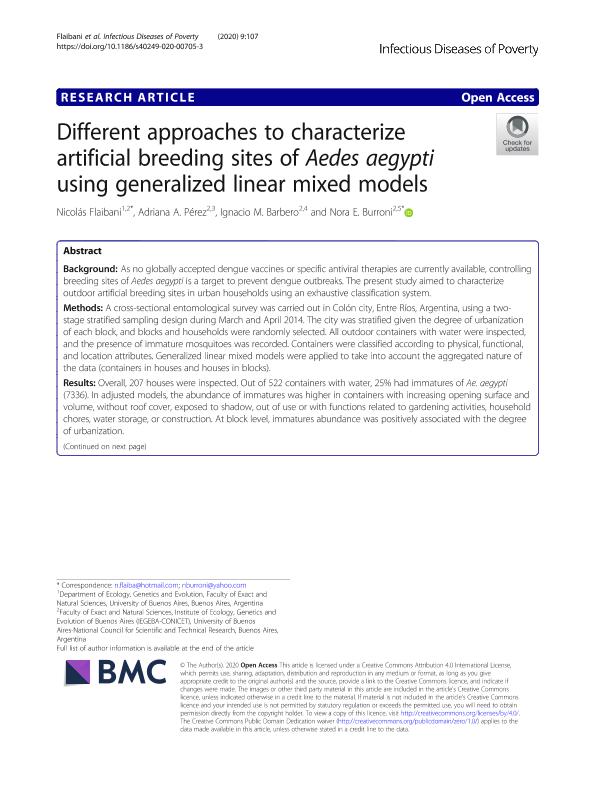Artículo
Different approaches to characterize artificial breeding sites of Aedes aegypti using generalized linear mixed models
Fecha de publicación:
07/2020
Editorial:
BioMed Central
Revista:
Infectious Diseases of Poverty
ISSN:
2095-5162
e-ISSN:
2049-9957
Idioma:
Inglés
Tipo de recurso:
Artículo publicado
Clasificación temática:
Resumen
Background: As no globally accepted dengue vaccines or specific antiviral therapies are currently available, controlling breeding sites of Aedes aegypti is a target to prevent dengue outbreaks. The present study aimed to characterize outdoor artificial breeding sites in urban households using an exhaustive classification system. Methods: A cross-sectional entomological survey was carried out in Colón city, Entre Ríos, Argentina, using a two-stage stratified sampling design during March and April 2014. The city was stratified given the degree of urbanization of each block, and blocks and households were randomly selected. All outdoor containers with water were inspected, and the presence of immature mosquitoes was recorded. Containers were classified according to physical, functional, and location attributes. Generalized linear mixed models were applied to take into account the aggregated nature of the data (containers in houses and houses in blocks). Results: Overall, 207 houses were inspected. Out of 522 containers with water, 25% had immatures of Ae. aegypti (7336). In adjusted models, the abundance of immatures was higher in containers with increasing opening surface and volume, without roof cover, exposed to shadow, out of use or with functions related to gardening activities, household chores, water storage, or construction. At block level, immatures abundance was positively associated with the degree of urbanization. Conclusions: We detected high immatures abundance in containers associated with water utilization. This suggests that containers involved in these activities, whether directly (e.g., water storage) or indirectly (e.g., incomplete water drainage in the last use), are susceptible to present a high immature abundance. Although our results indicate the importance of the type of use over the type of container, we encourage the use of both classification criteria for artificial breeding sites of mosquitoes, mainly because these are complementary. Additionally, generalized linear mixed models allowed us to analyse predictor variables at different scales (container/house/block) and consider the lack of independence between observations. An exhaustive analysis of artificial breeding sites that use this analytical methodology can lead to new information that could help designing more appropriate tools for dengue surveillance and control.
Palabras clave:
CONTAINERS
,
IMMATURE MOSQUITOES
,
VECTORS
Archivos asociados
Licencia
Identificadores
Colecciones
Articulos(CICYTTP)
Articulos de CENTRO DE INV.CIENT.Y TRANSFERENCIA TEC A LA PROD
Articulos de CENTRO DE INV.CIENT.Y TRANSFERENCIA TEC A LA PROD
Articulos(IEGEBA)
Articulos de INSTITUTO DE ECOLOGIA, GENETICA Y EVOLUCION DE BS. AS
Articulos de INSTITUTO DE ECOLOGIA, GENETICA Y EVOLUCION DE BS. AS
Citación
Flaibani, Nicolas; Pérez, Adriana Alicia; Barbero, Ignacio Matias; Burroni, Nora Edith; Different approaches to characterize artificial breeding sites of Aedes aegypti using generalized linear mixed models; BioMed Central; Infectious Diseases of Poverty; 9; 107; 7-2020; 1-11
Compartir
Altmétricas




